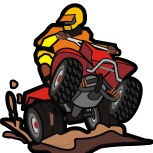Search the Community
Showing results for tags 'alignment'.
-
I thought I would make a quick "How-to" on setting wheel alignment since I was flipping my tie rod ends and I was going to have to re-align the wheels anyways. Here's some of the tools you will need... 1.) Start with the ATV on a smooth and level surface, like a cement garage floor or driveway. 2.)Center up (Eyeball It) the handle bars and lock them into place with 2 ratchet straps, one on each side of handle bars. This of course prevents them from moving when your adjusting the tie-rods. 3.) Place two Jack Stands approximately 2 feet in front of the atv even with the outside edge of the two front wheels. 4.) Wrap a length of string all the way around the ATV and Jack Stands, Start and end at the rear hitch. Make sure the string is the same height from the ground on all 4 wheels. I like to attach a few elastic bands to both ends of the string before attaching the string to the hitch. This makes it easier to adjust the strings when moving the Jack Stands. 4.) Break lose the inner and outer tie-rod nuts. NOTE! Make sure you use 2 wrenches, one on the nut and one on the ball joint. Damage can occur by only using one wrench. 5.) Adjust the string by moving the Jack Stands in or out untill the string just touches both of the side surfaces of the rear tires on each side of the ATV. This will take some time to get it right but it needs to be done! Check manufacturers wheel alignment specifications on your specific make and model before you adjust any components. For this wheel alignment I'm using the Polaris Specs which seems to be a common setting. Polaris - The recommended toe alignment is 1/8″ to 1/4″ toe out. This is a total amount, not per wheel. 6.) On the front rim, measure the distance from the string to the rim at the front and rear edges of the rim. The rear measurement should be 1/16″ - 1/8″ (.2 to .3 cm) more than the front measurement. 7.) If an adjustment is necessary, Turn the tie rod itself with a wrench or your hand in small increments. It doesn't take much to move the tire a long way, so go slow. Keep re-checking your measurement's until you have a 1/16″ - 1/8″ differance to the string. 6.) Once your satisfied that you have the correct "Toe Out" measurements you can tighten up the inner and outter tie-rod nuts on both sides. AGAIN...make sure to use 2 wrenches. 7.) Now take your ATV for a test drive to test your adjustments. If it still pulls one way or the other, just repeat the above steps to tweek the adjustments again utill your happy. The whole process only takes about 15-20 min.
-
having an alignment problem with the machine pulling to the right, it has new tires, no apparent wear on the steering components or damage. Does anyone have any experience aligning these machines?
-
Here's a good article and video on the basics when it comes to ATV front end wheel alignments. Source: http://www.cyclepedia.com/manuals/online/free/steering/atv-front-end-alignment/ When you hear the words front end alignment what comes to mind? Automobiles and potholes may be the first thought. There are other four wheeled vehicles out there running over a lot more than potholes. ATVs and side-by-sides live hard lives crawling over rocks, hauling loads, and crossing trails no other man-made vehicle would dare. One of the most basic services these vehicles call for is the adjustment of the toe-in of the front wheels. The Suzuki Eiger LT-F-400F calls for this to be checked initially after 100 mi. or 1 month of use, and every 600 mi. or 3 months for the rest of its operational life. Be it a Yamaha Banshee, 50cc mini-quad, or Kawasaki Mule this is a periodic maintenance item that is essentially the same no matter the scale of machine. Toe-in specifically refers to the amount the front wheels are pigeon toed. At axle level the center of the front tires are closer in the front than in the back. Most ATVs and side-by-sides call for the front wheels to be slightly pigeon toed to parallel. Keeping the toe-in aliment in specification and adjusted correctly is important for performance, safety, and tire wear. If the front end of the vehicle is in a toe-out position, duck footed, the tires will wear more rapidly and the vehicle will be inherently unstable. In addition, if the toe-in adjustment is in specification but it has been improperly adjusted it may put excess strain on the steering components. The first step in checking the toe-in is to check the tire pressure. Make sure the tire pressure set correctly in all four tires. The air pressure in the front tires should be as close to the same as possible. Place the vehicle on a level surface and position the steering straight ahead. Be sure to check with the appropriate service manual to see if there are any extra specifics for the vehicle. The Suzuki Eiger for example calls for the vehicle to be weighted as to simulate the rider. Make a chalk mark on the front, center of each front tire at the height of the front axle. If available set up a toe gauge so that the pointers line up with the chalk marks. Measure the distance between the front chalk marks. Record this measurement as A. Rotate the front wheels 180° so the marks remain at axle height, but are now facing to the rear. Record the distance between the marks on the backside of the tires as B. Subtract the front measurement A from the rear measurement B to calculate the toe-in. If the number is negative you have a toe-out condition. Compare your toe-in figure with the factory specification found in the vehicles service manual. To adjust the toe-in loosen the lock nuts on the tie-rods. The outer tie-rod lock nuts often have left hand threads. Turn the tie rods with a wrench at the flats to change the toe-in. Be sure to evenly adjust the left and right tie-rods for proper alignment. Check with the service manual to see if there are any specifications for the length of the tire rods or the amount of threads that should be showing. If the tie-rods are not adjusted according to the OEM specifications the proper toe-in may be achieved, but the vehicle will not steer correctly and it could be at risk of breaking a tie-rod. When the adjustment is correct hold the tie-rod flats and tighten the lock nuts to specification against each side of the tie-rod. Take a slow test ride to make sure the steering functions correctly. Check out this additional video on ATV wheel alignments:
- 31 replies
-
- 3
-

-
- atv alignment
- wheel alignment
-
(and 4 more)
Tagged with:
-
i have a 2005 honda 400ex that started pulling to the left. tie rods, air pressure are all good. but i noticed my rear axel is tweak a little. i measured the distance between the front and rear wheels at the center of the axles on both side. the distance betwen the right side is shorter from what i mesured on the left side of the quad. witch is what i think is causing it to pull to the left. does anyone know how i go about aligning the rear axle? thanks
-
OK, so brilliant me bent the piss out of one of my tie rods. I'm gonna buy some Lonestar rods. I don't see them being difficult to replace but how hard is it to align the tires? How do you make sure they are both straight?






